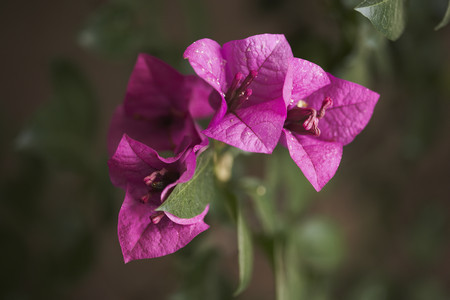Lack of iron may be source of odd-colored leaves

Last week I announced that I would be releasing a list of fruit trees recommended for the Las Vegas Valley after six years of evaluations at the University of Nevada Cooperative Extension Master Gardeners Orchard in North Las Vegas. I was overwhelmed with requests from the public for this list. Please be patient and everyone will receive this list as soon as it is completed.
Q: I have had two bougainvilleas in large planter pots for three years now. They are located on my 12-by-15-foot patio, which is surrounded by a 7-foot wall. They are staked and I have trellises in the pots to keep them off the wall because of the heat. They froze last winter; I cut them back and they came back very nicely except that the leaves were pale green with darker green veins. I put them on a feeding schedule of once a week with an all-purpose plant food and the leaves turned a nice, dark green again.
I was gone on vacation for two weeks and they have begun to revert to the light green leaves again, although I have fed them. Can you suggest a solution? They really are beautifully full and blooming.
A: It sounds as if the problem is iron chlorosis. Besides your all-purpose plant food you might want to consider adding an iron fertilizer, such as an iron chelate, to the soil in early spring prior to new growth. Most plants have begun to slow down their growth now in preparation for fall and winter so a soil-applied iron fertilizer will not do much good.
Your other option is to spray the foliage with an iron fertilizer multiple times to see if you can get the plant to take up the iron through the leaves. You should add a small amount of liquid detergent or spreader to this iron solution to help it penetrate the leaf surface. It is always best to apply fertilizers to foliage in the morning hours before it gets hot.
Q: I’ve had a problem with a brown patch in my lawn every year for the past several years. This year it seems to have spread into my neighbor’s yard. The man that owns the company that maintains my lawn doesn’t know what the cause might be. There is a sprinkler head very near the first brown patch as the lawn slopes down there. I didn’t think it was from too much water, as any excess could run off.
A: From the pictures you sent me, it does not appear to be disease related. If brown spots arise every year from about the same spot, then it is usually a weakness in the irrigation system and usually underwatered or poor water penetration in that area. Disease problems usually move from place to place relative to each other each year.
Try taking a bucket of water and adding a couple of tablespoons of liquid detergent and pouring it slowly on that area after you push some holes in that spot with a long screwdriver. The holes are to make sure the water is penetrating the soil. If water runs off of the area to the low spot between the yards, it may not penetrate to the roots.
The lawn looks like it is mowed too short. Fescue should be mowed no less than 11/2 inches in height and 2 inches would be better. The lawn also looks a bit off color and may need a light application of turfgrass fertilizer containing high levels of nitrogen. You can do that now as your fescue lawn needs a good application of fertilizer right around Thanksgiving anyway.
But try opening up that soil area with a hand aerator and see if you can get it to respond. Watering right now should most likely be every three days or so, early in the morning before the sun rises. And I would guess probably for a total of 12 to 15 minutes at each watering.
Break your water application into multiple applications totaling 12 to 15 minutes, with the applications about a half-hour to an hour apart. If there is no sprinkler at that corner of the shrub bed (near the brown spot), you might have to add one to get coverage.
Make sure you check for plugged nozzles and adequate pressure in your irrigation system. Consult the manufacturers’ specifications, which you can find on their Web sites, but it is usually between 30 and 55 psi.
Bob Morris is an associate professor with the University of Nevada Cooperative Extension. Direct gardening questions to the master gardener hot line at 257-5555 or contact Morris by e-mail at morrisr@unce.unr.edu.












